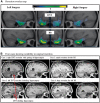Temporal lobe surgery in childhood and neuroanatomical predictors of long-term declarative memory outcome
- PMID: 25392199
- PMCID: PMC4285190
- DOI: 10.1093/brain/awu313
Temporal lobe surgery in childhood and neuroanatomical predictors of long-term declarative memory outcome
Abstract
The temporal lobes play a prominent role in declarative memory function, including episodic memory (memory for events) and semantic memory (memory for facts and concepts). Surgical resection for medication-resistant and well-localized temporal lobe epilepsy has good prognosis for seizure freedom, but is linked to memory difficulties in adults, especially when the removal is on the left side. Children may benefit most from surgery, because brain plasticity may facilitate post-surgical reorganization, and seizure cessation may promote cognitive development. However, the long-term impact of this intervention in children is not known. We examined memory function in 53 children (25 males, 28 females) who were evaluated for epilepsy surgery: 42 underwent unilateral temporal lobe resections (25 left, 17 right, mean age at surgery 13.8 years), 11 were treated only pharmacologically. Average follow-up was 9 years (range 5-15). Post-surgical change in visual and verbal episodic memory, and semantic memory at follow-up were examined. Pre- and post-surgical T1-weighted MRI brain scans were analysed to extract hippocampal and resection volumes, and evaluate post-surgical temporal lobe integrity. Language lateralization indices were derived from functional magnetic resonance imaging. There were no significant pre- to postoperative decrements in memory associated with surgery. In contrast, gains in verbal episodic memory were seen after right temporal lobe surgery, and visual episodic memory improved after left temporal lobe surgery, indicating a functional release in the unoperated temporal lobe after seizure reduction or cessation. Pre- to post-surgical change in memory function was not associated with any indices of brain structure derived from MRI. However, better verbal memory at follow-up was linked to greater post-surgical residual hippocampal volumes, most robustly in left surgical participants. Better semantic memory at follow-up was associated with smaller resection volumes and greater temporal pole integrity after left temporal surgery. Results were independent of post-surgical intellectual function and language lateralization. Our findings indicate post-surgical, hemisphere-dependent material-specific improvement in memory functions in the intact temporal lobe. However, outcome was linked to the anatomical integrity of the temporal lobe memory system, indicating that compensatory mechanisms are constrained by the amount of tissue which remains in the operated temporal lobe. Careful tailoring of resections for children undergoing epilepsy surgery may enhance long-term memory outcome.
Keywords: children; drug-resistant epilepsy; epilepsy surgery; hippocampus; memory.
© The Author (2014). Published by Oxford University Press on behalf of the Guarantors of Brain.
Figures



Comment in
-
Paediatric epilepsy surgery: making the best of a tough situation.Brain. 2015 Jan;138(Pt 1):4-5. doi: 10.1093/brain/awu320. Epub 2014 Nov 12. Brain. 2015. PMID: 25392200 Free PMC article.
Similar articles
-
Imaging memory in temporal lobe epilepsy: predicting the effects of temporal lobe resection.Brain. 2010 Apr;133(Pt 4):1186-99. doi: 10.1093/brain/awq006. Epub 2010 Feb 15. Brain. 2010. PMID: 20157009 Free PMC article.
-
Working memory network plasticity after anterior temporal lobe resection: a longitudinal functional magnetic resonance imaging study.Brain. 2014 May;137(Pt 5):1439-53. doi: 10.1093/brain/awu061. Epub 2014 Mar 31. Brain. 2014. PMID: 24691395 Free PMC article.
-
Neural basis of episodic memory in the intermediate term after medial temporal lobe resection.J Neurosurg. 2018 Oct 26;131(3):790-798. doi: 10.3171/2018.5.JNS18199. Print 2019 Sep 1. J Neurosurg. 2018. PMID: 30485238
-
Preoperative prediction of verbal episodic memory outcome using FMRI.Neurosurg Clin N Am. 2011 Apr;22(2):219-32, ix. doi: 10.1016/j.nec.2010.12.002. Neurosurg Clin N Am. 2011. PMID: 21435573 Free PMC article. Review.
-
Functional magnetic resonance imaging for assessment of language and memory in clinical practice.Curr Opin Neurol. 2005 Apr;18(2):161-6. doi: 10.1097/01.wco.0000162858.60144.ca. Curr Opin Neurol. 2005. PMID: 15791147 Review.
Cited by
-
Characterization and Prediction of Short-term Outcomes in Memory After Temporal Lobe Resection in Children With Epilepsy.Neurology. 2023 May 2;100(18):e1878-e1886. doi: 10.1212/WNL.0000000000207143. Epub 2023 Mar 16. Neurology. 2023. PMID: 36927884 Free PMC article.
-
Optimization of surgical intervention outside the epileptogenic zone in the Virtual Epileptic Patient (VEP).PLoS Comput Biol. 2019 Jun 26;15(6):e1007051. doi: 10.1371/journal.pcbi.1007051. eCollection 2019 Jun. PLoS Comput Biol. 2019. PMID: 31242177 Free PMC article.
-
Cognitive outcomes after magnetic resonance-guided laser interstitial thermal therapy for mesial temporal lobe epilepsy in adolescent patients.Epilepsy Behav Rep. 2024 Oct 29;28:100723. doi: 10.1016/j.ebr.2024.100723. eCollection 2024. Epilepsy Behav Rep. 2024. PMID: 39555496 Free PMC article.
-
When two are better than one: Bilateral mesial temporal lobe contributions associated with better vocabulary skills in children and adolescents.Brain Lang. 2018 Sep;184:1-10. doi: 10.1016/j.bandl.2018.06.001. Epub 2018 Jun 15. Brain Lang. 2018. PMID: 29913315 Free PMC article.
-
Holistic processing and face expertise after pediatric resection of occipitotemporal cortex.Neuropsychologia. 2024 Feb 15;194:108789. doi: 10.1016/j.neuropsychologia.2024.108789. Epub 2024 Jan 6. Neuropsychologia. 2024. PMID: 38191121 Free PMC article.
References
-
- Alpherts WCJ, Vermeulen J, van Rijen PC, da Silva FHL, van Veelen CWM. Verbal memory decline after temporal epilepsy surgery? A 6-year multiple assessments follow-up study. Neurology. 2006;67:626–31. - PubMed
-
- Andersson-Roswall L, Engman E, Samuelsson H, Malmgren K. Cognitive outcome 10 years after temporal lobe epilepsy surgery: a prospective controlled study. Neurology. 2010;74:1977–85. - PubMed
-
- Andersson-Roswall L, Malmgren K, Engman E, Samuelsson H. Verbal memory decline is less frequent at 10 years than at 2 years after temporal lobe surgery for epilepsy. Epilepsy Behav. 2012;24:462–7. - PubMed
Publication types
MeSH terms
Grants and funding
LinkOut - more resources
Full Text Sources
Other Literature Sources
Medical

